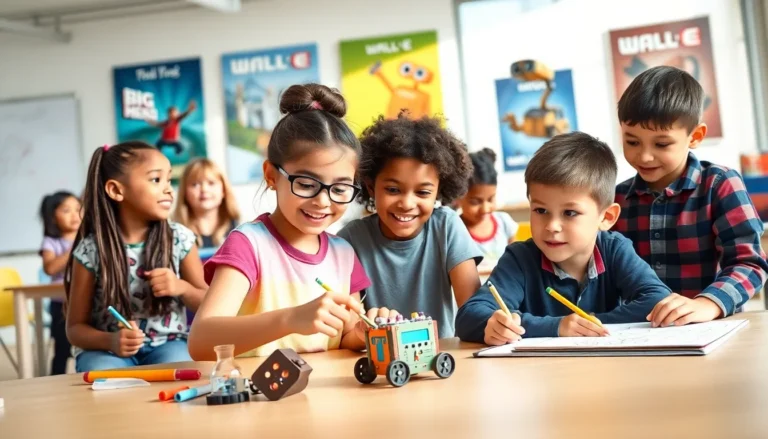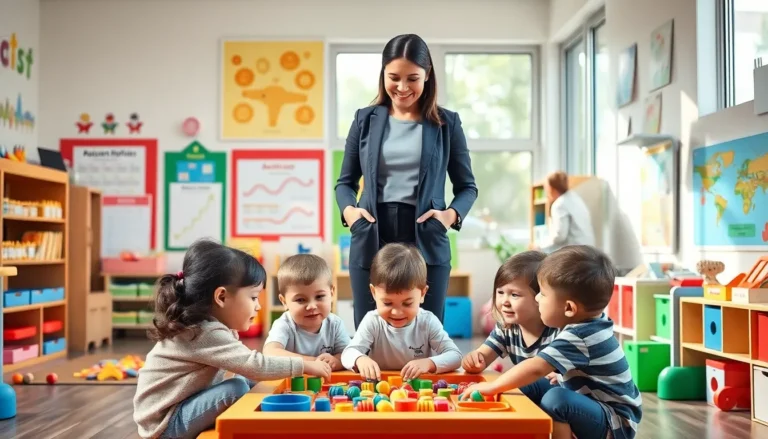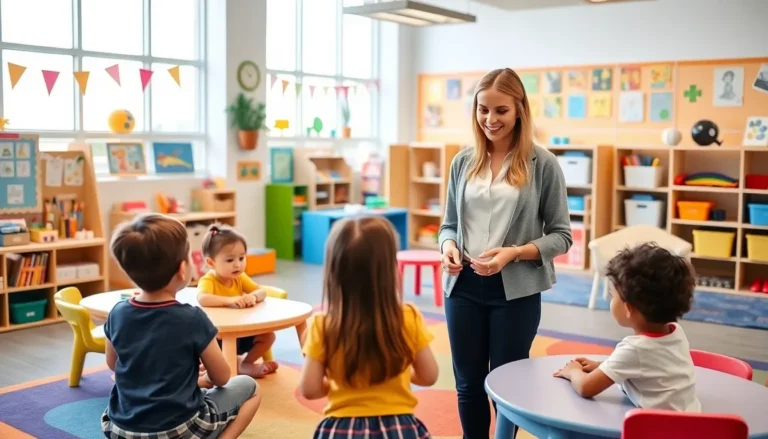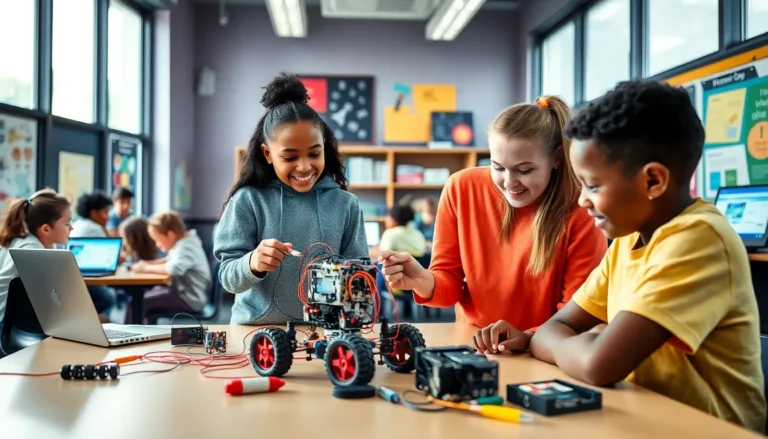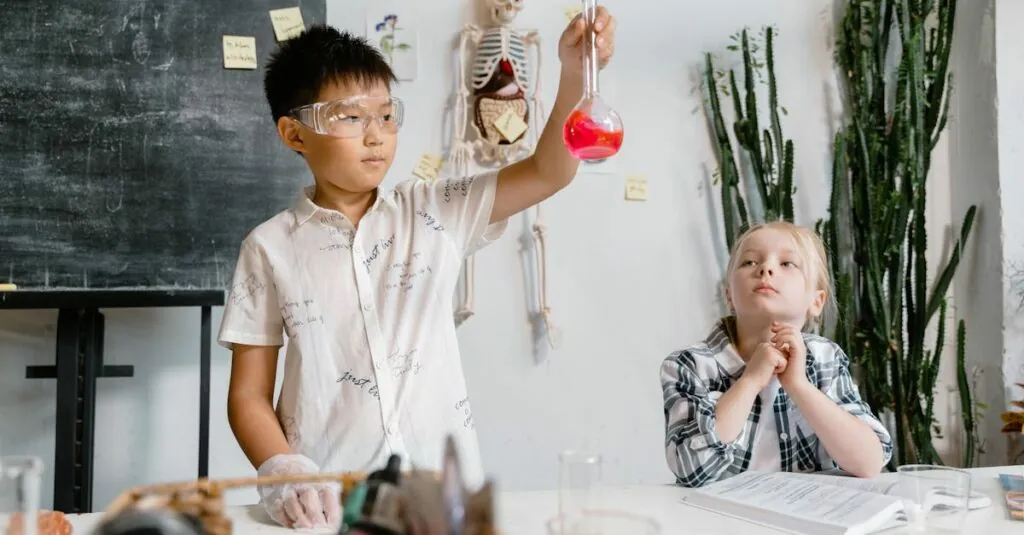Table of Contents
ToggleIn a world where kids are glued to screens, why not turn that screen time into brain time? STEM classes for kids are the ultimate playground for young minds, blending science, technology, engineering, and math into a fun-filled adventure. Imagine your child building robots while learning the secrets of coding or conducting experiments that make them feel like mini Einsteins.
These classes aren’t just about crunching numbers or memorizing formulas; they spark curiosity and creativity. With hands-on projects and exciting challenges, kids dive into the wonders of the universe while having a blast. So, if you want your child to be the next tech whiz or the future innovator, STEM classes are the ticket to a world of possibilities. Who knew learning could be this much fun?
Overview of STEM Classes for Kids
STEM classes for kids combine science, technology, engineering, and mathematics into interactive learning experiences. These classes encourage hands-on activities, such as building robots or coding projects. Engagement plays a key role in these lessons, capturing children’s attention and cultivating their creativity.
Children gain practical skills that support future learning opportunities. Robotics clubs enable them to understand engineering principles while honing teamwork skills. Coding camps teach programming languages, allowing kids to create their own games and applications. Experimentation with scientific concepts fosters critical thinking and problem-solving abilities.
Many educational institutions are integrating STEM curriculums into their standard offerings. By doing this, schools prepare students for a technology-driven future. Parents often report improved academic performance in subjects related to science and math after their children participate in STEM activities. Local organizations also provide extracurricular programs that enhance these skills outside the classroom.
Online platforms present additional resources for children interested in STEM. E-learning options offer flexibility, making it easier for kids to learn at their own pace. From virtual coding lessons to interactive science experiments, numerous resources cater to various learning styles.
Overall, STEM classes create a solid foundation for kids. As they explore these subjects, they build confidence and curiosity. Exposure to real-world applications ensures that kids develop a passion for lifelong learning, priming them for future careers in innovative fields.
Benefits of STEM Education
Engaging in STEM education provides numerous advantages that shape children’s development. It emphasizes practical skills, innovative thinking, and enjoyable learning experiences.
Enhancing Critical Thinking Skills
Critical thinking skills grow through STEM classes. Students tackle real-world problems and analyze data systematically. By engaging in hands-on projects, kids learn to evaluate outcomes and devise solutions. For example, a robotics project challenges them to troubleshoot issues and think critically about design flaws. Such activities encourage logical reasoning and improve overall problem-solving abilities, preparing students for future academic endeavors.
Promoting Creativity and Innovation
Creativity flourishes in STEM environments. Kids experiment with ideas while building and coding, which encourages original thoughts. They generate unique solutions to challenges, enhancing their inventive skills. Art and design principles often integrate with technology in these classes. For instance, designing a video game allows children to merge storytelling with coding, fostering creativity alongside technical knowledge. These experiences motivate them to explore diverse approaches, leading to innovative thinking in various fields.
Types of STEM Classes Available
STEM classes encompass a variety of subjects that engage children in meaningful ways. These classes inspire young learners to explore their interests across different fields.
Science Classes
Science classes immerse kids in the wonders of the natural world. Students conduct experiments that deepen their understanding of scientific concepts such as biology, chemistry, and physics. Through hands-on activities, children learn to formulate hypotheses, gather data, and draw conclusions. For instance, chemistry experiments allow them to observe reactions while understanding the scientific method. These experiences cultivate their curiosity and develop critical thinking skills.
Technology Classes
Technology classes focus on essential skills needed in a digital world. Learners gain proficiency in coding languages and digital tools, creating projects like websites and apps. Exposure to robotics teaches kids how machines operate and how to program them effectively. Engaging in technology projects helps students envision potential careers in tech and opens pathways for future learning. Creative problem-solving becomes a key focus as kids navigate challenges in their projects.
Engineering Classes
Engineering classes encourage children to design and build innovative solutions to real-world problems. Students participate in projects ranging from bridge construction to simple machines, applying principles of physics and mathematics. Working in teams fosters collaboration and communication skills, as they brainstorm ideas and test prototypes. Engineering challenges instill a mindset of persistence and adaptability, essential traits in any aspiring engineer.
Mathematics Classes
Mathematics classes offer a strong foundation in problem-solving and analytical thinking. Students tackle concepts like algebra, geometry, and data analysis through interactive lessons. Engaging with math-related games and projects makes learning enjoyable and relatable. While working on real-life applications, such as budgeting or building designs, kids see the relevance of mathematics in daily life. This approach not only enhances their skills but also encourages a positive attitude toward learning math.
Choosing the Right STEM Class
Selecting an appropriate STEM class ensures a child’s interests are nurtured while developing essential skills. Various factors contribute to this choice, including age and learning objectives.
Age Appropriateness
Age appropriateness plays a crucial role in maximizing engagement and understanding. Classes designed for younger children often emphasize hands-on activities and exploration. As kids grow, programs shift to challenging projects that foster critical thinking and problem-solving. Selecting classes that align with age not only enhances comprehension but also maintains motivation. For instance, a 5-year-old might enjoy simple robotics, while a 12-year-old benefits from advanced coding challenges. Tailoring the curriculum to age ensures kids grasp concepts without feeling overwhelmed.
Learning Objectives
Learning objectives outline the goals that each STEM class aims to achieve. Programs often focus on specific skill sets like coding or scientific inquiry. Enrichment in these areas supports overall academic performance. For example, a robotics program may include objectives such as teamwork, design thinking, and programming basics. Meanwhile, a science class might target experimentation skills and data analysis. Choosing a class with clear learning objectives helps parents ensure their children acquire applicable skills, setting a solid foundation for future learning.
STEM classes for kids create an engaging and enriching environment that fosters curiosity and creativity. By participating in hands-on projects and collaborative activities, children not only develop essential skills but also ignite a passion for learning. The diverse offerings in STEM education cater to various interests and age groups, ensuring that every child finds their niche. As they explore science, technology, engineering, and mathematics, kids are better equipped to tackle real-world challenges. This foundation not only enhances academic performance but also prepares them for future careers in innovative fields. Investing in STEM education today can lead to a brighter and more creative tomorrow for the next generation.

